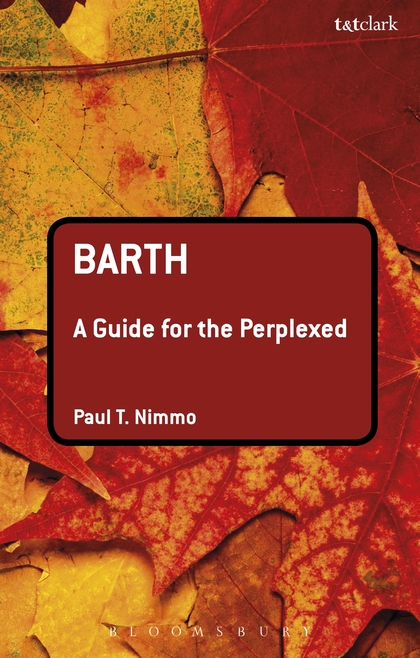Nimmo, Paul T., Barth: A Guide for the Perplexed (London: Bloomsbury T&T Clark, 2017). Pp. xiv + 210. ISBN: 978-0-567-03264-5
 Introductions to Karl Barth’s theology continue to arrive, each distinctive in its own way, and more or less helpful and memorable. Those new to Barth and seeking an entry to his major work will find Paul Nimmo’s new book a helpful guide, fulfilling its purpose in the Bloomsbury series. Nimmo’s approach to his subject is straight-forward. After an initial survey of Barth’s life, and an orientation to his theology in chapter one, there follow six chapters in which Nimmo provides terse expositions, or better, synopses, of the various sections of the Church Dogmatics, interspersed with brief reflective comments on Barth’s doctrine in those sections. Thus chapter two examines the first volume of the Dogmatics—the doctrine of the Word of God. Chapter three details volume two on the doctrine of God, and chapter four addresses the doctrine of creation in volume three of the work. Nimmo breaks the pattern when he reaches volume four. He devotes two chapters to an exposition of the doctrine of reconciliation, and here, instead of working through each part-volume in order as he has in the other chapters, he works through each doctrinal theme across the part-volumes, thus treating each doctrine as a unity rather than in parts as Barth did. Chapter five gives attention to Barth’s Christology and his doctrine of sin, while chapter six examines his soteriology, and the work of the Spirit in the church and in Christian life. This method of exposition has the advantage of providing a clear overview of each of these doctrines in a unified account. The final chapter is also a departure from a straight-forward exposition. In this chapter Nimmo treats Barth’s ethics, drawing together material from the each of the volumes, and including a brief exposition of the lectures published posthumously as The Christian Life.
Introductions to Karl Barth’s theology continue to arrive, each distinctive in its own way, and more or less helpful and memorable. Those new to Barth and seeking an entry to his major work will find Paul Nimmo’s new book a helpful guide, fulfilling its purpose in the Bloomsbury series. Nimmo’s approach to his subject is straight-forward. After an initial survey of Barth’s life, and an orientation to his theology in chapter one, there follow six chapters in which Nimmo provides terse expositions, or better, synopses, of the various sections of the Church Dogmatics, interspersed with brief reflective comments on Barth’s doctrine in those sections. Thus chapter two examines the first volume of the Dogmatics—the doctrine of the Word of God. Chapter three details volume two on the doctrine of God, and chapter four addresses the doctrine of creation in volume three of the work. Nimmo breaks the pattern when he reaches volume four. He devotes two chapters to an exposition of the doctrine of reconciliation, and here, instead of working through each part-volume in order as he has in the other chapters, he works through each doctrinal theme across the part-volumes, thus treating each doctrine as a unity rather than in parts as Barth did. Chapter five gives attention to Barth’s Christology and his doctrine of sin, while chapter six examines his soteriology, and the work of the Spirit in the church and in Christian life. This method of exposition has the advantage of providing a clear overview of each of these doctrines in a unified account. The final chapter is also a departure from a straight-forward exposition. In this chapter Nimmo treats Barth’s ethics, drawing together material from the each of the volumes, and including a brief exposition of the lectures published posthumously as The Christian Life.
Nimmo’s comments at the conclusion of each section highlight areas of ongoing conversation or dispute in Barth studies (for example, with respect to the doctrine of election), or methodological insights (for example, Barth’s grounding of the divine perfections in scriptural exposition). He is aware of contentions with respect to Barth’s interpreters, shows the various sides of the arguments, but remains impartial with respect to the issues. Although his own commitments are not the focus of his exposition, they do surface at times as part of his discussion. Thus Nimmo takes up common concerns that Barth is fideist, or has no place for human agency, or that his soteriology is universalist. In particular, he emphasises the event nature of God’s being and work, as well as the work of the Holy Spirit, especially in the doctrine of reconciliation. Although it is clear that Nimmo writes with great sympathy for the Barth’s project, he is no epigone, writing that “although theologians today should certainly think about Barth and with Barth, they are also called to think after Barth in their work, acknowledging that he does not have the final word” (201). While we do well to learn from the Swiss master, we do even better to follow in his way of doing theology with “responsible obedience” and “joyful freedom,” attending to the revelation given us in Christ, and aiming at the witness of this same Jesus Christ in the world.
Nimmo has provided a well-written and able overview of Barth’s Church Dogmatics. That he could accomplish this task in a work of this size is quite remarkable. That he succeeds in making Barth’s magnum opus accessible for those wanting to engage the Church Dogmatics is a worthy achievement. The real success of his work, however, will be measured in accordance with those who, having read this introduction, go on to read Barth for themselves, and then to think with Barth and after Barth in their own contexts.